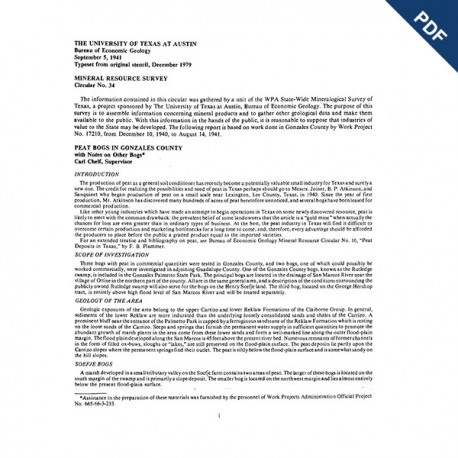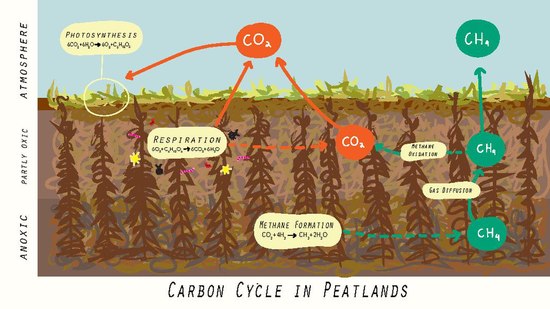‘Peat is neat’ Water Filtering Challenge Time needed for activity 45 minutes Location Outdoor area or near a water source Context This activity plan focuses on how peat, in the uplands and wetland bogs, helps to retain and naturally filter water. Understanding the structure and nature of peatlands can lead to better management techniques. Milled peat is commonly produced by large scale mechanized peat extractions, whereas the other two are produced on a smaller scale by manual, semi-mechanical or mechanical methods, either in dry or in wet conditions. Milled peat is a heterogeneous mixture of loose peat particles which are cut from the surface of the peatswamp. 3.0 m (total peat depth at the sampling locations ranged from 3.4 m to 4.0 m, Table 1).Each sample was augered out from an area approximately 30 cm in diameter, to a depth of 20 cm. The locations of the sampling sites are given in Table 1 3and basic properties of the peat are summarised in Table 2. Preparation of specimens. Study on Strength of Peat Soil Stabilised with Cement and Other Pozzolanic 435 Fig. 3: Peat Soil Mix. 4: Testing of Peat Soil Sample in UCC Machine 3.3 Determination of Strength for Lime Treated Soil The lime is added to the peat soil sample as percentage of dry soil mass in the range of 10%,30% and 50% respectively. Accessibility Requirements Considering accessibility is important both when creating a PDF and when publishing a PDF on the internet. PDF Requirements Requirements for PDF accessibility include, but are not limited to: PDFs should always have an accessible alternative, such as HTML, Word, Text, or RTF; PDFs must be tagged with accessibility features, such as: Headings and.
What is peat?
Peat is the surface organic layer of a soil that consists of partially decomposed organic matter, derived mostly from plant material, which has accumulated under conditions of waterlogging, oxygen deficiency, high acidity and nutrient deficiency.
In temperate, boreal and sub-arctic regions, where low temperatures (below freezing for long periods during the winter) reduce the rate of decomposition, peat is formed mainly from bryophytes (mostly sphagnum mosses), herbs, shrubs and small trees.
Peat formation
The habitat requirements for peat initiation and accumulation are similar in every geographical location (waterlogging, low pH, low nutrient availability, low oxygen supply, reduced decomposition rate) but the physical and chemical characteristics differ according to specific site characteristics of landscape area and topography, climate, water depth and flow, nutrient availability and biogeographical availability of plant species.
Peat for horticulture
Peat is used in horticulture, as a soil improver and ingredient of growing media.
The volume used annually is about half that of fuel peat. Germany and Canada account for over half of horticultural peat extraction.
Principles of polymerization odian solution manual. Other important peat production countries are the Baltic states, Finland, Ireland and Sweden but also Chile and Argentina.
Peat for heat and power
Peat has been an important local or regional energy source in Finland, Ireland and Sweden. (Joosten & Clarke, 2002, Wise Use of Mires and Peatlands).
Due to environmental pressures, increasing carbon trade prices and the climate targets the amount of peat for energy has declined drastically during the last few years.
Other uses
In addition to energy and horticulture, peat is used ex-situ as a raw material for chemistry (wax, dye, activated carbon, humic preparations, corrosion inhibition), as a bedding material for animals (horses, chicken, pigs), as a filter and absorbent material (oil spills, heavy metal removal, microbial carries)and also for peat textiles (cotton grass fibres, paper).
Organic soil
Some peatland authorities consider soils with surface organic layer less than 30% also to be peat but this is debateable. This approach gives rise to larger estimates of the global area of peatland although it does not increase the carbon store appreciably.
Organic soil is differentiated according to the degree of decomposition of organic matter. There are four Suborders of Histosol, namely, Fibrists, Hemists, Saprists and Folists. The first three represent increasing degree of decomposition and decreasing evidence of plant remains while the last is tree litter overlying rock or rubble.
Rate of peat accumulation and terrestrialisation
The rate at which organic matter accumulates to form ‘peat’ depends on the productivity of the aquatic vegetation that in turn is determined by the nutrient content of the water and, initially, the mineral substrate.
Shallow eutrophic lakes experience all stages of the hydrosere more quickly than deep eutrophic lakes or oligotrophic ones, whatever their depth.
Deep oligotrophic lakes may never infill because the productivity of plants growing in and around their margins is low owing to the lack of nutrients in the water, giving rise to a small annual plant biomass that is decomposed after each growing season.
Wise Use of Peatlands
Wise Use of peatlands can be described as the uses of peatlands for which reasonable people now and in the future will not attribute blame.
IPS has developed a framework for Wise Use to resolve conflicts between different values and uses of mires and peatlands. Overall, the major – anthropocentric – conflicts which arise with respect to peatland use are between those who wish to develop mires and peatlands for their production or carrier functions, and others who wish to preserve them for their regulation and non-material life-support functions.
Responsible peatland management means undertaking activities in a transparent and accountable manner, following ethical and humanitarian principles applied in ways that promote stewardship of the peatland resource that will be acceptable to future generations.
A responsible approach to managing peatland and peat considers its effect on people and ecosystem services, and balances environmental, social and economic functions.
Certification for peat extraction
The intention of certification is to ensure that peatland will be used, managed and restored in a responsible way. Currently there are two schemes in use, RPP and Veriflora.
Peat suppliers
If you are looking for peat suppliers or peat producers, please contact the following companies or associations (most but not all of them are IPS members).
Peat & Peatland Dictionary
The following PDF contains a complete list of almost 7000 peat and peatland related terms in English, German, Finnish, Swedish and Russian. For searching a certain term, click the link below and search the term using Ctrl F (Cmd F on Mac). You may also download the file on your device. Peat Dictionary – complete
What are peatlands?
Peatland is a terrestrial wetland ecosystem in which the production of organic matter exceeds its decomposition and a net accumulation of peat results.
Peatlands occur in every climatic zone and continent. The total area globally is around 4 million km2 making them 70% of natural freshwater wetland or 3% of the Earth’s land surface.
Peatlands include landscapes that are still actively accumulating peat (mires), others that are no longer accumulating and do not support the principal peat forming plants (e.g. Sphagnum spp.), and peatland used for economic uses such as agriculture, forestry and excavation for energy generation, horticulture and a few other…
Where can peatlands be found?
The distribution of peatlands globally follows that of wetlands generally.
The largest known concentrations of peatland are found in Canada and Alaska, Northern Europe and Western Siberia, Southeast Asia, and parts of the Amazon basin, where more than 10% of the land area is covered with peatlands.
Functions of Peatlands

According to the “Wise Use of Mires and Peatlands” by Donal Clarke and Hans Joosten (2002), the following functions of mires and peatlands can be identified:
Types of peatlands
Countries classify their peatlands differently, but most agree on two main classes: bogs and fens (with some swamps being a third).
Most commonly known special peatland types are e.g. aapa mires, blanket bogs, palsa mires, spring fens, and tropical peat swamp forest. Many languages have special peatland expressions with even regional differences.
Mire classification and typology
The classification of mires is confusing not only because of major regional differences but also different criteria have been used which vary in space and time and therefore represent continua of change rather than discrete differences.
There are numerous accounts of different approaches to classification of mires on a country and regional basis according to different typologies.
Ecosystem services
Ramona The Pest Pdf
Peatland ecosystem services are the benefits that people obtain from peatland.
Ray Peat Pdf
Kimmel and Mander (2010) offered a summary of peatland ecosystem services and examples of relevant beneficial functions adapted from the Millennium ecosystem assessment (2005) and Joosten and Clarke (2002):
Peatlands and Biodiversity
The term biodiversity is used to describe the variety of all life on earth including all plants and animals, and the ecosystems which sustain them.
Pet Pdf
Peatlands sustain a rich and unique range of habitats and species across the world. At the level of individual peatland sites the diversity of organisms can be exceptional.
Peatlands and Climate

Peatlands interact with climate through the uptake and release of greenhouse gases (GHGs).

Since peatlands store large amounts of organic matter in their soils, they represent stores of carbon.
This carbon has been taken out of the atmosphere as carbon dioxide (CO2) by peatland plants in the process of photosynthesis.
Peatland Restoration
Peatland Restoration is a term used to describe management measures that aim to restore the original form and function of peatland habitats to favourable conservation status.
Analisis Pest Pdf
The principal activity involved in restoration is management of site hydrology which in turn helps to control emissions of greenhouse gases such as carbon dioxide.
Agriculture on Peatlands
Approximately 14% of European peatlands are currently used for agriculture. Large areas are found in Russia, Germany , Belarus, Poland and Ukraine.
In Canada is it estimated that 40 thousand hectares of peatlands are under cultivation. Over 230 thousand hectares of fen peatlands are cultivated in the Florida Everglades.
Forestry on Peatlands
From the forestry point of view, peatlands have two main features that make timber production more challenging than in non-peated mineral soil sites.

The most evident is the high water content in the soil. The other is soil nutrient status, which is generally sufficient with nitrogen but deficient with phosphorus, potassium and some micronutrients.
Wise Use of Peatlands
Wise Use of peatlands can be described as the uses of peatlands for which reasonable people now and in the future will not attribute blame.
IPS has developed a framework for Wise Use to resolve conflicts between different values and uses of mires and peatlands.
Responsible Management
Responsible peatland management means undertaking activities in a transparent and accountable manner, following ethical and humanitarian principles applied in ways that promote stewardship of the peatland resource that will be acceptable to future generations.
A Strategy for Responsible Peatland Management (SRPM) implementation was published by the International Peatland Society in 2010 following discussions and contributions involving more than 100 peatland and peat stakeholders from many countries.
Peatlands and Society
People utilize peatlands in many different ways and peatlands mean different things to different people.
Tropical and temperate peatlands have vastly different uses, histories and contemporary threats.
The social and cultural perspectives of peatlands must be understood in order for these values of peatlands to be acknowledged in decision making for peatland management.
Peat & Peatland Dictionary
The following PDF contains a complete list of almost 7000 peat and peatland related terms in English, German, Finnish, Swedish and Russian. For searching a certain term, click the link below and search the term using Ctrl F (Cmd F on Mac). You may also download the file on your device. Peat Dictionary – complete